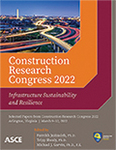The Impact of Natural Disaster Affected Housing Service Sector on the Interrelated Industries
Publication: Construction Research Congress 2022
ABSTRACT
The loss of critical infrastructure owing to natural disasters is an important issue for our society. The property damage and economic perturbations in the housing service sector due to natural disasters will lead to the inoperability of interrelated infrastructure and sectors. The major objectives are to define deterministic relationships between different infrastructure for strengthening the resilience and security of the housing service infrastructure in the event of natural disasters. This research conducts economic impact analysis that is the process of predicting the outcomes from a project using historical economic data. This study attempts to identify crucial infrastructure from the most affected to the least with respect to their interdependencies with the housing service sector. In case of loss in the housing service infrastructure or sectors due to natural disasters, identifying which critical infrastructure or sectors will be the most affected will be helpful to minimize the risks and property damages.
Get full access to this article
View all available purchase options and get full access to this chapter.
REFERENCES
Anderson, C., Santos, J., and Haimes, Y. (2007). A Risk-based Input–Output Methodology for Measuring the Effects of the August 2003 Northeast Blackout. Economic Systems Research, 19(2), 183–204.
Antoušková, M. (2010). Measuring the impacts of financial supports based on input–output analysis. 1211 –555X, 1211 – 555X.
Borgonovo, P. (2010). Uncertainty Importance and Risk-Based Decision Making in the Inoperability Input–Output Model. Procedia - Social and Behavioral Sciences, 2(6), 7621.
Chen, R. J. C. (2017). Effects of climate change in North America: An overview. Journal of Sustainable Development, 4(3), 32.
Crowther, K., and Haimes, Y. (2005). Application of the inoperability input–output model (IIM) for systemic risk assessment and management of interdependent infrastructures. Systems Engineering, 8(4), 323–341.
Crowther, K., Haimes, Y., and Taub, G. (2007). Systemic Valuation of Strategic Preparedness Through Application of the Inoperability Input–Output Model with Lessons Learned from Hurricane Katrina. Risk Analysis, 27(5), 1345–1364.
Duchin, F., and Szyld, D. (1985). A Dynamic Input–Output Model with Assured Positive Output. Metro economic, 37(3), 269–282.
Greenberg, M., and Lowrie, K. (2012). From the editors. Inoperability input–output model. Risk Analysis: An Official Publication of the Society for Risk Analysis, 32(1), 1–2.
Haimes, Y., and Jiang, P. (2001). Leontief-Based Model of Risk in Complex Interconnected Infrastructures. Journal of Infrastructure Systems, 7(1), 1–12.
Haimes, Y., Horowitz, B., Lambert, J., Santos, J., Lian, C., and Crowther, K. (2005). Inoperability Input–Output Model for Interdependent Infrastructure Sectors. I: Theory and Methodology. Journal of Infrastructure Systems, 11(2), 67–79.
Horowitz, K. J., and Mark, A. (2006). Planting. Concepts and Methods of the us input-Output Accounts. Bureau of Economic Analysis.
Jiang, P., and Haimes, Y. (2003). Input -output Inoperability Risk Model and Beyond: A Holistic Approach, ProQuest Dissertations and Theses, University of Virginia.
Jonkeren, O., and Giannopoulos, G. (2014). Analyzing critical infrastructure failure with a resilience inoperability input– output model. Economic Systems Research, 26(1), 1–21.
Kerkhof, A. C., Nonhebel, S., and Moll, H. C. (2009). Relating the environmental impact of consumption to household expenditures: An input–output analysis. Ecological Economics, 68(4), 1160–1170.
Lahr, M. L., Dietzenbacher, E., and Som, G. (2001). Input–output analysis: Frontiers and extensions.
Li, J., Crawford‐Brown, D., Syddall, M., and Guan, D. (2013). Modeling Imbalanced Economic Recovery Following a Natural Disaster Using Input–Output Analysis. Risk Analysis, 33(10), 1908–1923.
Ma, H., Shih, H., Hung, M., Chao, C., and Li, P. (2012). Integrating input output analysis with risk assessment to evaluate the population risk of arsenic. Environmental Science & Technology, 46(2), 1104–10.
Orsi, M., and Santos, J. (2010). Probabilistic modeling of workforce-based disruptions and input– output analysis of interdependent ripple effects. Economic Systems Research, 22(1), 3–18.
Polenske, K. (1995). Leontief’s spatial economic analyses. Structural Change and Economic Dynamics, 6(3), 309–318.
Rose, A., Sue Wing, I., Wei, D., and Wein, A. (2016). Economic Impacts of a California Tsunami. Natural Hazards Review, 17(2), 04016002.
Santos, J. (2006). Inoperability input–output modeling of disruptions to interdependent economic systems. Systems Engineering, 9(1), 20–34.
Shen, Z., Yang, L., Pei, J., Li, M., Wu, C., Bao, J., Wei, T., Di, Z., Rousseau, R., and Wu, J. (2016). Interrelations among scientific fields and their relative influences revealed by an input–output analysis. Journal of Informatics, 10(1), 82–97.
Thomas, A. (2013). Estimating direct and indirect rebound effects for U.S. households with input–output analysis. Part 2: Simulation. Ecological Economics, 86, 188–198.
Xie, W., Rose, A., Li, S., He, J., Li, N., and Ali, T. (2018). Dynamic Economic Resilience and Economic Recovery from Disasters: A Quantitative Assessment. Risk Analysis, 38(6), 1306–1318.
Zhang, J. (2008). A Multi-sector Nonlinear Dynamic Input–Output Model with Human Capital. Economic Systems Research, 20(2), 223–237.
Information & Authors
Information
Published In
History
Published online: Mar 7, 2022
Authors
Metrics & Citations
Metrics
Citations
Download citation
If you have the appropriate software installed, you can download article citation data to the citation manager of your choice. Simply select your manager software from the list below and click Download.
